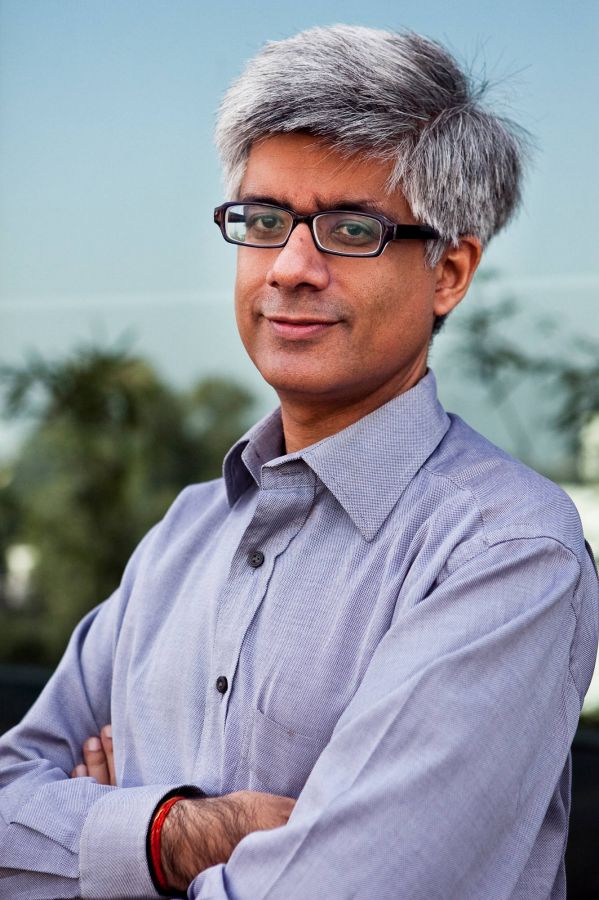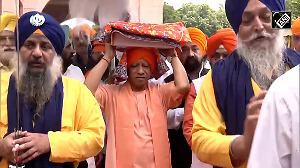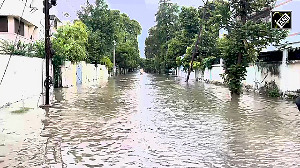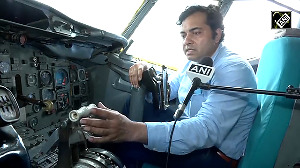 According to a report published by Lancet Global Health, the Bill and Melinda Gates Foundation-funded Avahan programme, first launched in India in 2003, might have prevented over 6 lakh HIV infections in India in the last 10 years,
According to a report published by Lancet Global Health, the Bill and Melinda Gates Foundation-funded Avahan programme, first launched in India in 2003, might have prevented over 6 lakh HIV infections in India in the last 10 years,
The Avahan India AIDS Initiative was implemented in Andhra Pradesh, Maharashtra, Tamil Nadu, Manipur and Nagaland.
Alkesh Wadhwani is the head, India programs, Bill and Melinda Gates Foundation. He has been with the foundation from 2003, overseeing its India based programs. Before that, he led the $350 million HIV prevention program of the foundation in India.
Wadhwani is an electrical engineer from IIT Mumbai and an MBA from IIM, Calcutta (Kolkata).
In this interview with rediff.com’s Shobha Warrier, he talks about how the Avahan India Project could prevent over 6 lakh cases in the last 10 years.
When the Avahan India Project was launched in 2003, was the HIV/AIDS scene in India quite alarming?
At that time, the prevalence of HIV was 1 percent among the general population in each of the four major states (Andhra Pradesh, Maharashtra, Karnataka and Tamil Nadu) we worked in. It had the potential to become worse and was a serious public health problem.
How different was the situation in India compared to other countries when the Bill and Melinda Gates Foundation decided to work in India?
It was not as bad as what it was in many of the sub Saharan African countries like South Africa, Botswana, etc. where the prevalence was as high as 10-20 percent and in some cases, it was even more than 20 percent. The bulk of the infection is still in the Sub Saharan Africa. In a span of 10-15 years, it has gone up from 1%-15 percent.
We decided to work here in India because from 1995 till 2003, it was showing an alarming growth. We felt if we don't intervene at that stage, the situation may turn bad. It was the right time for prevention. 1 percent is alarming in India when you look at the population of the country, and it is called generalised epidemic.
In India, you chose the southern states except Kerala. Was the incidence very high in these states compared to the other states?
The prevalence was as high as 20-25 percent in some of the pockets in these states like in the coastal AP, cities like Mumbai, and Pune, especially among the sex workers. It meant 1 in 4 sex workers were HIV+. Similarly in northern Karnataka, in places like Bagalkot, traditional sex workers were HIV+ as they didn’t know about protection.
The sex workers are the high risk group as men who go to these women get it and from them, their wives and children. So, it is a public health problem.
When we started working, we also found that there were a lot of male sex workers too. So, we decided to work with both male and female sex workers.
How did the foundation choose to work in an area? In association with the NGOs? If so, how did you choose the NGOs?
Actually we are only a funding organisation and we do not implement anything on our own. We only work with those NGOs who work at the ground level. What we did was, we chose a mother NGO in a state and it choose local NGOs. We have given the freedom to the mother NGO to choose the local NGOs who have the best infrastructure to work with various communities on the ground.
We have over 150 local NGOs in each of the cities working with sex workers and MSM (men having sex with men).
Other than funding, are there any other inputs from Avahan India Project?
We try to empower the communities so that they are able to solve their own problems, which we call community mobilisation. We also give technical help to the NGOs in setting up Community Based Organisations. For example, we found that condoms were not used much by sex workers because there was so much resistance by their customers. So we tried educating them. Today we also encourage the communities to save money.
We also regularly measure the impact of what we are doing by using internal data. These are the kind of technical support we give to see that the program is running well.
Were the ideas based on your work in other countries, or were they specifically designed for India?
It is a combination of both. We have a technical panel consisting of some of world's leading experts who guide us on the technical issues. Then, each country has its own problems and we have to deal with them differently. For example, condoms have been there for ages, and what we had to do here was, make the sex workers use it.
Had you decided to concentrate only on prevention and not on treatment?
Yes, we had decided on prevention and link our work to the government that offers treatment in government hospitals. In the first two years, the government had not started offering ART (antiretroviral therapy) but when they started offering ART free, we linked the sex workers to the program so that they could avail it.
How much was the initial funding by the foundation?
We first looked at the intensity of the epidemic in each place and decided on how much money was needed for intervention. We found that 70-80 percent of the epidemic was in those four states, and that was why we chose the states. Then, we did a survey to find out how many sex workers, MSM and transgenders are there in each place. We identified 250,000 sex workers, MSM and drug users and 6 million clients of the sex workers.
Then, we made an assessment of how much it would cost to roll out the program for 5 years, and found out that it would be around $200 million (about Rs 1,250 crore) for 5 years. That was our budget.
When did you start seeing positive results of your work?
By 2006, we started seeing the trend coming down and it has been coming down every year. In 2008, we found that the epidemic has really come down. From 1.5 percent in 2003, it has come down to 0.3 percent which is 75 percent down. We were quite happy about this.
After five years of work, did you change the focus and strategy of your work?
From 2006, we started working closely with the government in sharing the knowledge we have on the epidemic. Our role is not to run the program forever but create a model. It is the role of the government to run the program. Then, we sat with the government to find out when they will take over the program.
So, our second program was how to hand over the programs smoothly to the government while continuing to support the programs for some more time. So we first started giving technical inputs and by 2009 and 2012, we handed over majority of our programs to the government.
When I say that we handed over to the government, it meant the same NGOs now get funded by the government.
You said the foundation works with the high risk groups like the sex workers and MSM while in the north-east, the incidence of HIV is mainly among the drug users. When did you start working with them and is the strategy different?
We started working with the drug users roughly at the same time, around 2004 and the only difference is that they are drug users. The government itself has a package of services for them, and we also followed it. One strategy is that you give clean needles to them if they are using needles. That is a part of government approved policy to prevent the virus from spending.
All these drug users have abscesses where they have swelling around the place where they regularly use needles and it can cause other problems like infections. We also work on the abscesses.
Here, we are not trying to prevent drug usage which of course is not good. So the other strategy is to give them other drugs that are approved medically so that you can slowly wean them of the drugs. We also did some pilot projects.
The 2011 Lancet Global Report says over 6 lakh HIV/AIDS cases were prevented by the work done by the foundation.
We are extremely happy that incidence of HIV has come down in India, and we could prevent over 6 lakh cases in the last 10 years. The fact is it is not only in the districts we work in but also in the districts the government works, the incidence has come down substantially.
How did the report come to the conclusion that over 6 lakh cases of HIV were prevented by the Avahan project?
A tailor-made mathematical model of HIV transmission among high-risk groups and the general population was parameterised using data from serial cross-sectional surveys within a Bayesian framework, to reproduce HIV prevalence trends amongst female sex workers, their clients, men who have sex with men and the general population in 24 south Indian districts.
We tested whether these prevalence trends were more consistent with self-reported increases in consistent condom use (CCU) following Avahan or a counterfactual assuming CCU increased at slower pre-Avahan rates using a Bayesian factor, which gave a measure of the strength of evidence for the impact estimates.
Using regression analysis, the prevention impact in the 24 districts was extrapolated to all Avahan districts. Based on this model, the authors estimated that 606,000 infections were averted across all 69 Avahan districts in South India, over ten years.
Till when will the Avahan Project be here in India?
From 1 percent, the incidence has come down to 0.03 percent. We consider our work to be successful so far.
We will work for another 3-4 years to see that the communities have the ability to work for themselves like getting funds, providing condoms, interacting with the government, etc. without our support.
We have set 2017 as the deadline for community empowerment and then the community will take over the projects and see that HIV is not there among them.
Image: Project head Alkesh Wadhwani









